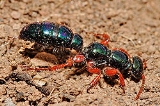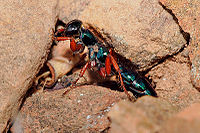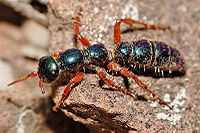
Blue ant
Encyclopedia
The blue ant is, despite its name and its appearance, not an ant
at all, but rather a species of large solitary parasitic
wasp
sometimes known as a flower wasp. It is a native of south and southeast Australia
, including the Australian states of Tasmania
, New South Wales
, Victoria
and South Australia
. It is the sole member of the subfamily Diamminae, and is both morphologically and behaviorally unusual among members of the family Tiphiidae
.
Blue ants have a distinctive metallic blue-green body, with red legs. The female ranges up to 25 mm (1 inch) in length, is wingless and ground-dwelling, and exclusively hunts mole cricket
s, whereas all other species of tiphiids attack beetle
larva
e. The cricket is paralysed with venom
injected by the female's stinger
and an egg is laid upon it so the wasp larva has a ready supply of food. The male is smaller, approximately 15 mm (0.5 inches), and has wings
. Adults feed on nectar, and pollinate
various native Australian flowers.
The sting can cause a severe burning sensation and swelling in humans; in rare cases, it can cause a life threatening reaction (such as anaphylaxis
).


Ant
Ants are social insects of the family Formicidae and, along with the related wasps and bees, belong to the order Hymenoptera. Ants evolved from wasp-like ancestors in the mid-Cretaceous period between 110 and 130 million years ago and diversified after the rise of flowering plants. More than...
at all, but rather a species of large solitary parasitic
Parasitoid
A parasitoid is an organism that spends a significant portion of its life history attached to or within a single host organism in a relationship that is in essence parasitic; unlike a true parasite, however, it ultimately sterilises or kills, and sometimes consumes, the host...
wasp
Wasp
The term wasp is typically defined as any insect of the order Hymenoptera and suborder Apocrita that is neither a bee nor an ant. Almost every pest insect species has at least one wasp species that preys upon it or parasitizes it, making wasps critically important in natural control of their...
sometimes known as a flower wasp. It is a native of south and southeast Australia
Australia
Australia , officially the Commonwealth of Australia, is a country in the Southern Hemisphere comprising the mainland of the Australian continent, the island of Tasmania, and numerous smaller islands in the Indian and Pacific Oceans. It is the world's sixth-largest country by total area...
, including the Australian states of Tasmania
Tasmania
Tasmania is an Australian island and state. It is south of the continent, separated by Bass Strait. The state includes the island of Tasmania—the 26th largest island in the world—and the surrounding islands. The state has a population of 507,626 , of whom almost half reside in the greater Hobart...
, New South Wales
New South Wales
New South Wales is a state of :Australia, located in the east of the country. It is bordered by Queensland, Victoria and South Australia to the north, south and west respectively. To the east, the state is bordered by the Tasman Sea, which forms part of the Pacific Ocean. New South Wales...
, Victoria
Victoria (Australia)
Victoria is the second most populous state in Australia. Geographically the smallest mainland state, Victoria is bordered by New South Wales, South Australia, and Tasmania on Boundary Islet to the north, west and south respectively....
and South Australia
South Australia
South Australia is a state of Australia in the southern central part of the country. It covers some of the most arid parts of the continent; with a total land area of , it is the fourth largest of Australia's six states and two territories.South Australia shares borders with all of the mainland...
. It is the sole member of the subfamily Diamminae, and is both morphologically and behaviorally unusual among members of the family Tiphiidae
Tiphiidae
Tiphiidae is a family of large solitary wasps whose larvae are almost universally parasitoids of various beetle larvae, especially those in the superfamily Scarabaeoidea....
.
Blue ants have a distinctive metallic blue-green body, with red legs. The female ranges up to 25 mm (1 inch) in length, is wingless and ground-dwelling, and exclusively hunts mole cricket
Mole cricket
The mole crickets compose family Gryllotalpidae, of thick-bodied insects about long, with large beady eyes and shovel-like forelimbs highly developed for burrowing and swimming. They can also fly: the adult mole cricket may fly as far as during mating season, is active most of the year, and...
s, whereas all other species of tiphiids attack beetle
Beetle
Coleoptera is an order of insects commonly called beetles. The word "coleoptera" is from the Greek , koleos, "sheath"; and , pteron, "wing", thus "sheathed wing". Coleoptera contains more species than any other order, constituting almost 25% of all known life-forms...
larva
Larva
A larva is a distinct juvenile form many animals undergo before metamorphosis into adults. Animals with indirect development such as insects, amphibians, or cnidarians typically have a larval phase of their life cycle...
e. The cricket is paralysed with venom
Venom
Venom is the general term referring to any variety of toxins used by certain types of animals that inject it into their victims by the means of a bite or a sting...
injected by the female's stinger
Stinger (organ)
A sting, sometimes called a stinger in the US, is a sharp organ or body part found in various animals that delivers some kind of venom . A true sting differs from other piercing structures in that it pierces by its own action and injects venom, as opposed to teeth, which pierce by the force of...
and an egg is laid upon it so the wasp larva has a ready supply of food. The male is smaller, approximately 15 mm (0.5 inches), and has wings
Insect wing
Insects are the only group of invertebrates known to have evolved flight. Insects possess some remarkable flight characteristics and abilities, still far superior to attempts by humans to replicate their capabilities. Even our understanding of the aerodynamics of flexible, flapping wings and how...
. Adults feed on nectar, and pollinate
Pollination
Pollination is the process by which pollen is transferred in plants, thereby enabling fertilisation and sexual reproduction. Pollen grains transport the male gametes to where the female gamete are contained within the carpel; in gymnosperms the pollen is directly applied to the ovule itself...
various native Australian flowers.
The sting can cause a severe burning sensation and swelling in humans; in rare cases, it can cause a life threatening reaction (such as anaphylaxis
Anaphylaxis
Anaphylaxis is defined as "a serious allergic reaction that is rapid in onset and may cause death". It typically results in a number of symptoms including throat swelling, an itchy rash, and low blood pressure...
).


External links
- Blue-ant Fact File (from the Australian MuseumAustralian MuseumThe Australian Museum is the oldest museum in Australia, with an international reputation in the fields of natural history and anthropology. It features collections of vertebrate and invertebrate zoology, as well as mineralogy, palaeontology, and anthropology...
) - Flower wasps (from the Australian MuseumAustralian MuseumThe Australian Museum is the oldest museum in Australia, with an international reputation in the fields of natural history and anthropology. It features collections of vertebrate and invertebrate zoology, as well as mineralogy, palaeontology, and anthropology...
) - Insect identification and advice (from CSIRO EntomologyEntomologyEntomology is the scientific study of insects, a branch of arthropodology...
) - Common names (and image) (from CSIRO EntomologyEntomologyEntomology is the scientific study of insects, a branch of arthropodology...
)

